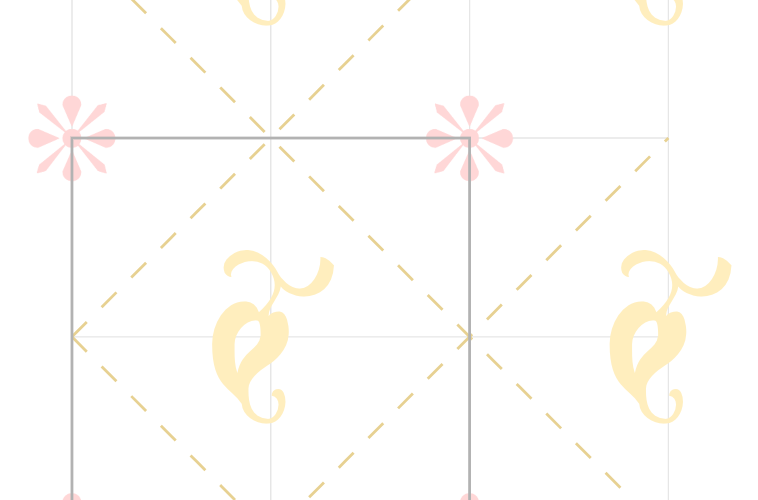We’ve covered before how to use the wallpaper package to create a background for your documents using, amongst others, tiled images in a previous post. But at times I really want to create patterns from existing LaTeX font ornaments or TikZ drawings, rather than using an extra image file.
The tcolorbox package has a fill tile picture option that can be used with arbitrary TikZ code:

But from experience, repeatedly running TikZ code can result in long compilation times, especially if you were planning to use design a tile pattern as the background to all pages. Saving a TikZ tile drawing as a LaTeX box, and then repeating that, would compile much faster.
So, OK, let’s give this a try and design some tiles! *crackles knuckles*
Designing a Tile
I’m no designer, so I thought I would just fumble along and try to mock up something first, before cropping/clipping things down to the required tile element. The adforn package provides some subtle ornaments, so I’ll use those as a start to play around on a grid to help me lay things out:
\usepackage{adforn} \begin{document} \definecolor{blossompink}{HTML}{FFD7D7} \definecolor{fruitgold}{HTML}{FFEEBE} \definecolor{stictchbrown}{HTML}{E7D192} \begin{tikzpicture}[x=1cm,y=1cm,domain=0:3] \draw[step=1cm,black!10,very thin] (0cm,0cm) grid (3cm,3cm); \foreach \x in {0,1} { \foreach \y in {0,1} { \node[font=\Huge,text=blossompink] at (2*\x, 2*\y) {\adforn{5}}; \node[font=\Huge,text=fruitgold] at (2*\x+1, 2*\y+1) {\adforn{35}}; } } \begin{scope}[dashed,stictchbrown] \draw plot (\x,\x-1); \draw plot (\x,\x+1); \draw plot (\x,-\x+1); \draw plot (\x,-\x+3); \end{scope} \end{tikzpicture} |
 That looks pretty good to me! And I only need a 4-by-4 unit of this sketch (the dark gray square) to make me a tile, which I can get with a
That looks pretty good to me! And I only need a 4-by-4 unit of this sketch (the dark gray square) to make me a tile, which I can get with a \clip (0,0) rectangle (2,2); at the start of the TikZ code.
This can then go into a \savebox for later use:
\newsavebox{\tileone} \sbox{\tileone}{% \begin{tikzpicture}[x=1cm,y=1cm] \clip (0,0) rectangle (2,2); \foreach \x in {0,1} { \foreach \y in {0,1} { \node[font=\Huge,text=blossompink] at (2*\x, 2*\y) {\adforn{5}}; \node[font=\Huge,text=fruitgold] at (2*\x+1, 2*\y+1) {\adforn{35}}; } } \begin{scope}[dashed,stictchbrown] \draw plot (\x,\x-1); \draw plot (\x,\x+1); \draw plot (\x,-\x+1); \draw plot (\x,-\x+3); \end{scope} \end{tikzpicture}% } |
If you \usebox{tileone}, you’ll see this:

And we can now use this with tcolorbox‘s fill tile picture option:
\begin{tikzpicture} \path[draw,fill tile picture={% \node[inner sep=0pt,outer sep=0pt,fill=blue!40!black] {\scalebox{0.5}{\usebox{\tileone}}}; }] (2.75,-0.75) -- (3,0) -- (2.75,0.75) \foreach \w in {45,90,...,315} { -- (\w:1.5cm) } -- cycle; \end{tikzpicture} |

This can also be easily made into a whole-page background. I usually (ab)use the page header to get it in:
\usepackage{fancyhdr} \usepackage{tikzpagenodes} \fancyhf{} \renewcommand{\headrule}{} \fancyhead[L]{% \begin{tikzpicture}[overlay,remember picture] \path[fill tile picture={% \node[inner sep=0pt,outer sep=0pt] {\usebox{\tileone}}; }] (current page.south east) rectangle (current page.north west); \fill[opacity=0.4,white] ([shift={(-1em,1em)}] current page text area.north west) rectangle ([shift={(1em,-1em)}]current page text area.south east); \end{tikzpicture} } \begin{document} \thispagestyle{fancy} |



The extra thumbnails shows designs that uses pgfornament-han and pgfornament just for fun; might be a bit over the top there though. Enjoy designing your new backgrounds, but do take care not to be over-flamboyant to the point of being too distractive, and repeating things too many times on too many pages will still take a long time to compile, despite already using \usebox!









